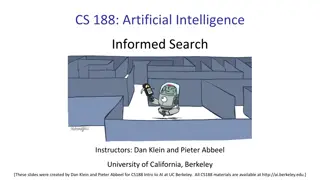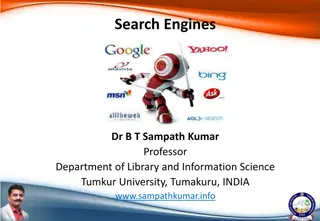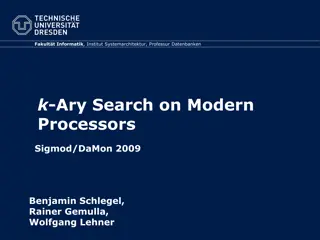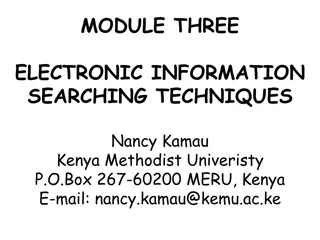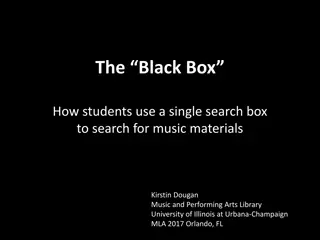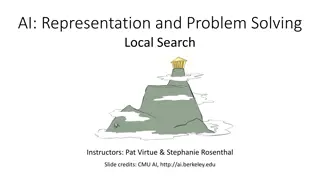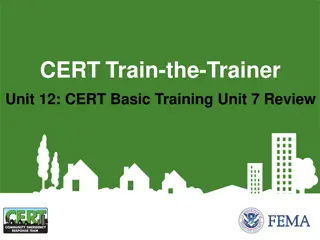
Local Search Algorithms: Problem-Solving Techniques and Examples
Explore local search algorithms in optimization problems, including hill-climbing and gradient descent. Learn to navigate obstacles like local optima and discover solutions using iterative improvements. Dive into examples like the 4-queens problem to enhance your problem-solving skills in computer science.
Download Presentation

Please find below an Image/Link to download the presentation.
The content on the website is provided AS IS for your information and personal use only. It may not be sold, licensed, or shared on other websites without obtaining consent from the author. If you encounter any issues during the download, it is possible that the publisher has removed the file from their server.
You are allowed to download the files provided on this website for personal or commercial use, subject to the condition that they are used lawfully. All files are the property of their respective owners.
The content on the website is provided AS IS for your information and personal use only. It may not be sold, licensed, or shared on other websites without obtaining consent from the author.
E N D
Presentation Transcript
Local Search COURSE: CS60045 Pallab Dasgupta Professor, Dept. of Computer Sc & Engg 1 INDIAN INSTITUTE OF TECHNOLOGY KHARAGPUR
Lecture Objectives Learning the concept of problem solving using local improvements Learning the concept of getting stuck in local optima Learning the ways to get out of local optima Local search algorithms REFERENCE Artificial Intelligence A Modern Approach, Stuart J Russell and Peter Norvig , Pearson Education India 2
Local search algorithms In many optimization problems, the path to the goal is irrelevant; the goal state itself is the solution Local search: widely used for very big problems Returns good but not optimal solutions in general The state space consists of "complete" configurations For example, every permutation of the set of cities is a configuration for the traveling salesperson problem The goal is to find a close to optimal configuration satisfying constraints Examples: n-Queens, VLSI layout, exam time table Local search algorithms Keep a single "current" state, or small set of states Iteratively try to improve it / them Very memory efficient since only a few states are stored 3
Example: 4-queens Goal: Put 4 queens on an 4 4 board with no two queens on the same row, column, or diagonal State space: All configurations with the queens in distinct columns State transition: Move a queen from its present place to some other square in the same column Local Search: Start with a configuration and repeatedly use the moves to reach the goal Move queen in Column 4 Move queen in Column 2 The last configuration has fewer conflicts than the first, but is still not a solution 4
Hill-climbing: A greedy approach THE IDEA: Make a move only if the neighboring configuration is better than the present one The dual of Hill Climbing is Gradient Descent. Hill climbing is for maximizing, Gradient Descent is for minimizing Source: Artificial Intelligence A Modern Approach, Peter Norvig and Stuart Russell, Prentice Hall 5
Gradient Descent in 8-queens Value[state] = The numbers pairs of queens that are attacking each other, either directly or indirectly. Value[state] = 17 for the state shown in the Fig. The number in each square is the value of state if we move the queen in the same column to that square. Therefore the best greedy move is to move a queen to a square labeled with 12. There are many such moves. We choose one of them at random. 6
Gradient descent can get stuck in local minima Each neighbor of a minimum is inferior with respect to the minimum No move in a minimum takes us to a better state than the present state Starting state Flat Local minimum Local minimum Shoulder Global minimum 7
Local minimum in 8-queens A local minimum with only one conflict All one-step neighbors have more than one conflict How to get out of local minima? 8
Idea-1: Gradient Descent with Random Restart Using many random restarts improves our chances Restart a random initial state, many times Report the best result found across many trials Starting state - 3 Starting state - 1 Starting state - 2 Flat Local minimum Local minimum Shoulder Global minimum 9
Idea-2: Allow moves to inferior neighbors To get out of a local minimum, we must allow moves to inferior neighbors However, we must ensure that we do not oscillate among a set of states IDEAS Simulated Annealing: Allow moves to inferior neighbors with a probability that is regulated over time. We discuss this in more details later Tabu Search: Add recently visited states to a tabu-list. These states are temporarily excluded from being visited again Forces solver away from explored regions Avoid getting stuck in local minima (in principle) 10
Simulated annealing search IDEA: Escape local maxima by allowing some "bad" moves but gradually decrease their probability The probability is controlled by a parameter called temperature Higher temperatures allow more bad moves than lower temperatures Annealing: Lowering the temperature gradually Quenching: Lowering the temperature rapidly function SIMULATED-ANNEALING( problem, schedule ) current INITIAL-STATE[ problem ] for t 1 to do T schedule[ t ] if T = 0 then return current next a randomly selected successor of current E VALUE[ next ] VALUE[ current ] if E < 0 then current else current next with probability ? Starting state Flat Local minimum Local minimum Shoulder Global minimum next ?? 11
How simulated annealing works ? ?? ??= Probability of making a bad move = ? ? B C E1 E2 A Since E1> E2moving from A to C is exponentially more probable than moving from A to B 12
Properties of Simulated Annealing It can be proven that: If T decreases slowly enough, then simulated annealing search will find a global optimum with probability approaching 1 Since this can take a long time, we typically use a temperature schedule which fits our time budget and settle for the sub-optimal solution Simulated annealing works very well in practice Widely used in VLSI layout, airline scheduling, etc. 13
Hill Climbing in Continuous Multi-variate State Spaces Denote state as ; cost as J( ) ??(?) ?? Choose a direction in which J( ) is decreasing ?(?) Derivative: ??(?) ?? Positive derivative means increasing Negative derivative means decreasing Move: A short uphill step in the chosen direction 14
Local Search with Multiple Present States Instead of working on only one configuration at any time, we could work on multiple promising configurations concurrently LOCAL BEAM SEARCH Maintain k states rather than just one. Begin with k randomly generated states In each iteration, generate all the successors of all k states Stop if a goal state is found; otherwise Select the k best successors from the complete list and repeat GENETIC ALGORITHMS States are strings over a finite alphabet (genes). Begin with k randomly generated states (population). Select individuals for next generation based on a fitness function. Two types of operators for creating the next states: Crossover: Fit parents to yield next generation (offspring) Mutation: Mutate a parent to create an offspring randomly with some low probability 15
Genetic Algorithm for 8 Queens Fitness function: # non-attacking pairs ( min = 0, max = 8 7 / 2 = 28 ) Population fitness = 24+23+20+11 = 78 P( Gene-1 is chosen ) = Fitness of Gene-1 / Population fitness = 24 / 78 = 31% P( Gene-2 is chosen ) = Fitness of Gene-2 / Population fitness = 23 / 78 = 29% 16
Concluding Remarks Memory usage is one of the determining factors for choosing a search algorithm For large state spaces, local search is an attractive practical option For local search: It is important to understand the tradeoff between time and solution quality It is important to understand the shape of the state space to decide things like temperature schedule in simulated annealing, durations of locking of moves in tabu search, and number of random restarts in gradient descent Local search is not a push-button solution 17
Exercise Problem Consider the problem of finding the shortest path between two points on a plane that has convex polygonal obstacles. This is an idealization of the problem a robot has to solve to navigate its way around in a crowded environment. In the figure, the origin O is at coordinates (0, 0). The start state is at (1, 5). The goal is at (10, 5). The robot cannot see those regions which are occluded by the obstacles. Suppose the state space consists of all positions (x, y) in the plane. How many states exist? How many paths are there to the goal? We are interested in the shortest path to the goal. This runs along the corners of the polygons and therefore consists of line segments that connect the polygon s corners. We formulate the state space to contain the corners of all polygons as well as the start and goal coordinates. State the full successor function for the states (1, 5) (start) and (3, 4) in the problem shown in the figure. We will now use hill-climbing in the same setting, that is, planar robot navigation among polygonal obstacles. We assume that the obstacles do not touch each other. Explain how hill-climbing would work as a method of reaching a particular end point. Is it guaranteed to find the path? Show how nonconvex obstacles can result in a local maximum for the hill-climber, using an example 18







